To help you improve your customer interactions, I’ve put together some suggestions based on best practices and what has worked for me in the past. Let’s go!
Table of Contents
What Are Customer Interactions?
Customer interactions are any communication between your business and its customers. These instances occur throughout the customer journey and can relate to marketing campaigns, sales promotions, support, etc.
I’ve found that customers interact with businesses for many reasons and through various channels (phone, email, live chat, social media, and in-person). Each customer interaction is an opportunity to understand your customers, fulfill their needs, and delight them.
I think of customer interaction as any touchpoint between my business and the customer, whether big or small. For example, my main business is my band, Juice. Loyal fans (customers) will approach us after our concerts to give us hugs and chat, which is a different customer interaction from someone who buys a t-shirt from us at our merch table.
Why Are Customer Interactions Important?
Customer interactions provide invaluable information that can help improve customer satisfaction and strengthen your business overall. Here’s why I think customer interactions are paramount:
- Customer interactions are your gateway to understanding their needs, preferences, and pain points. If you can understand what your customers need and why they behave like they do, you can tailor your products and services to meet their expectations.
- Positive customer interactions make customers feel good about their relationship with your brand. When customers feel valued and understood through positive interactions, they are less likely to leave you for the competition.
- If you can make each customer interaction easy and enjoyable, you will likely create loyal customers who stick around longer, spend more money, and refer you to friends and family.
- The feedback you gather from customer interactions will highlight what’s working and where there is room for improvement. That’s invaluable data for improving the quality of your products, services, and customer experience.
Focusing on customer interaction quality has led to sustainable growth and strong customer relationships in my businesses. Instead of obsessing over revenue and leads, I obsess over delighting my customers at each possible touchpoint and learning from those interactions to better serve their needs.
The Customer Interaction Cycle
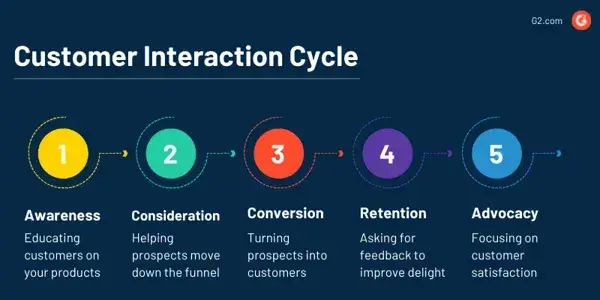
The Customer Interaction Cycle is a framework for understanding customer interactions based on the customer journey. It consists of five key stages where customer interactions are likely to occur. I’ve found that customer interactions differ based on which stage the customer is in. Here’s what to expect:
1. Awareness
At this stage, customers are early in their purchasing journey. They have recently become aware of your brand and are searching for more information on your products and services and how you can help them solve their needs.
Example: I recently decided that I’m tired of wearing my Apple Watch during my boxing training. It’s bulky and sometimes hurts my wrist, but I don’t want to give up posting my workouts to Strava. One of my training partners mentioned chest strap heart rate monitors that I can wear to track my workouts while keeping my wrists free. Once I learned that, I started my research.
2. Consideration
Moving into the consideration stage, the customer is fully aware of your brand and evaluates whether your product or service can meet their needs. They will discover your unique value proposition, compare it to competitors, and decide if it suits their requirements.
Example: After searching online and scouring Amazon, I found a few heart rate monitor options that suited my needs. Most do the same thing, but I narrowed it down to a couple of chest straps that fit my budget and sync with the apps I use. Comparing features and reading reviews was instrumental in helping me make an informed decision.
3. Conversion
In the conversion stage, the customer purchases your product or service and officially becomes a customer. Members of the sales team typically handle interactions at this stage.
Example: As a musician, I buy all my gear from Sweetwater. No matter how big or small a purchase I make, I can always expect a call from Nick, my personal Sweetwater sales rep, to thank me personally for my purchase and even ask me how things are going with the band. If that’s not an above-and-beyond customer interaction, I don’t know what it is.
4. Retention
At the retention stage, the brand cultivates positive interactions with existing customers to maintain satisfaction. You might do so through successful customer service interactions, check-ins from success teams, and soliciting and acting on customer feedback.
Example: Continuing with the Sweetwater example, sometimes Nick will call me out of the blue to ask me how I’m getting along with my new bass, strings, pedal, or whatever I may have bought in the past six months. In moments like that, Nick acts more like a Customer Success Manager, checking in to ensure my success with their products. These positive customer interactions make me feel good about my relationship with Sweetwater and encourage me to stick around.
5. Advocacy
In the advocacy stage, companies convince loyal customers to become brand promoters. This can be accomplished through intentional customer interactions such as sending gifts, thank you letters, or offering referral incentives.
Example: Goodwill cultivated through a history of positive customer interactions can convince customers to sing your praises without even needing to ask — case in point: me. I just told you all about how great Sweetwater is, and they never asked me to or offered me a dime. Their exceptional service and dedication to positive customer interactions throughout my customer journey have turned me into a brand advocate.
When you understand each stage of the customer interaction cycle, you can tailor interactions that enhance the customer experience throughout their journey.
Examples of Customer Interactions
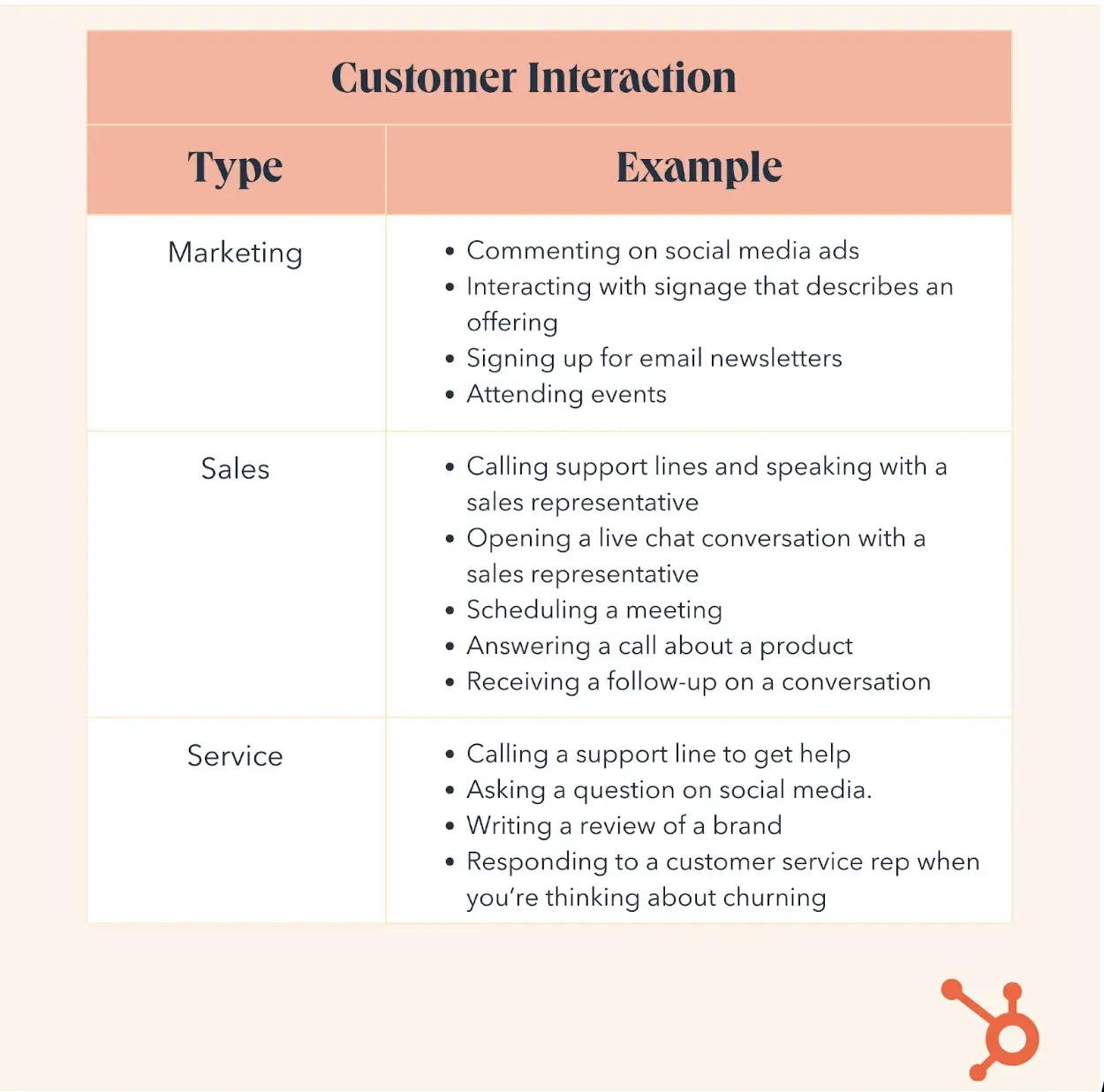
Customer Interactions in Marketing
- A customer sees an advertisement for your brand on social media and comments on it.
- A customer signs up for your email newsletter for weekly updates and promotions.
- A customer attends one of your company events.
Customer Interactions in Sales
- A customer calls your business to inquire about a product.
- A customer initiates a live chat conversation with a sales rep on your site.
- A sales rep follows up via email to provide additional information after a meeting.
Customer Interactions in Customer Service
- A customer calls your support line to get help with an issue.
- A customer reaches out on social media with questions about your product.
- A customer success manager reaches out to a customer who is showing signs of churn.
As a small business owner, I don’t have separate departments for marketing, sales, and support (they are all me). However, I’ve had customer interactions that fit into the above categories, and I can’t stress enough that every touchpoint matters, whether small or seemingly insignificant.
As you can see above, many things qualify as customer interactions — a lot more than I listed. So, how are you supposed to keep track of so many customer interactions? That’s where Customer Interaction Management (CIM) software comes into play.
Customer Interaction Management (CIM)
CIM software is a tool used to manage and record interactions between your company and its customers across multiple channels.
I use HubSpot CRM as the CIM software for my other business, Tri-State Backline, an instrument rental company. My favorite part is the contact timeline, which shows me the complete chronological history of every interaction I’ve had with a customer.
Let’s say a customer visits my site and submits a form. I reply via email and then call the customer to set up a rental. All those customer interactions are listed clearly in the form of a timeline on the customer’s contact record. It looks something like this:
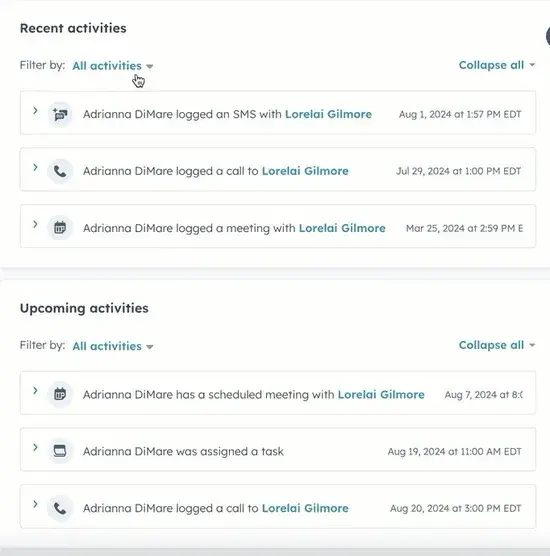
Using CIM software in my business has streamlined my processes and made it easy to access a complete history of customer interactions, so I’m never in the dark about customer needs or previous concerns.
Here are some benefits of adopting CIM software:
- Centralized communication. Recording all customer communications in one place makes it easy to keep track of conversations.
- Enhanced personalization. Access to past customer interactions gives you the context necessary for personalized communications.
- Data-driven decisions. Most CIM software will provide analytics and reports to uncover patterns in customer interactions and improve the customer experience.
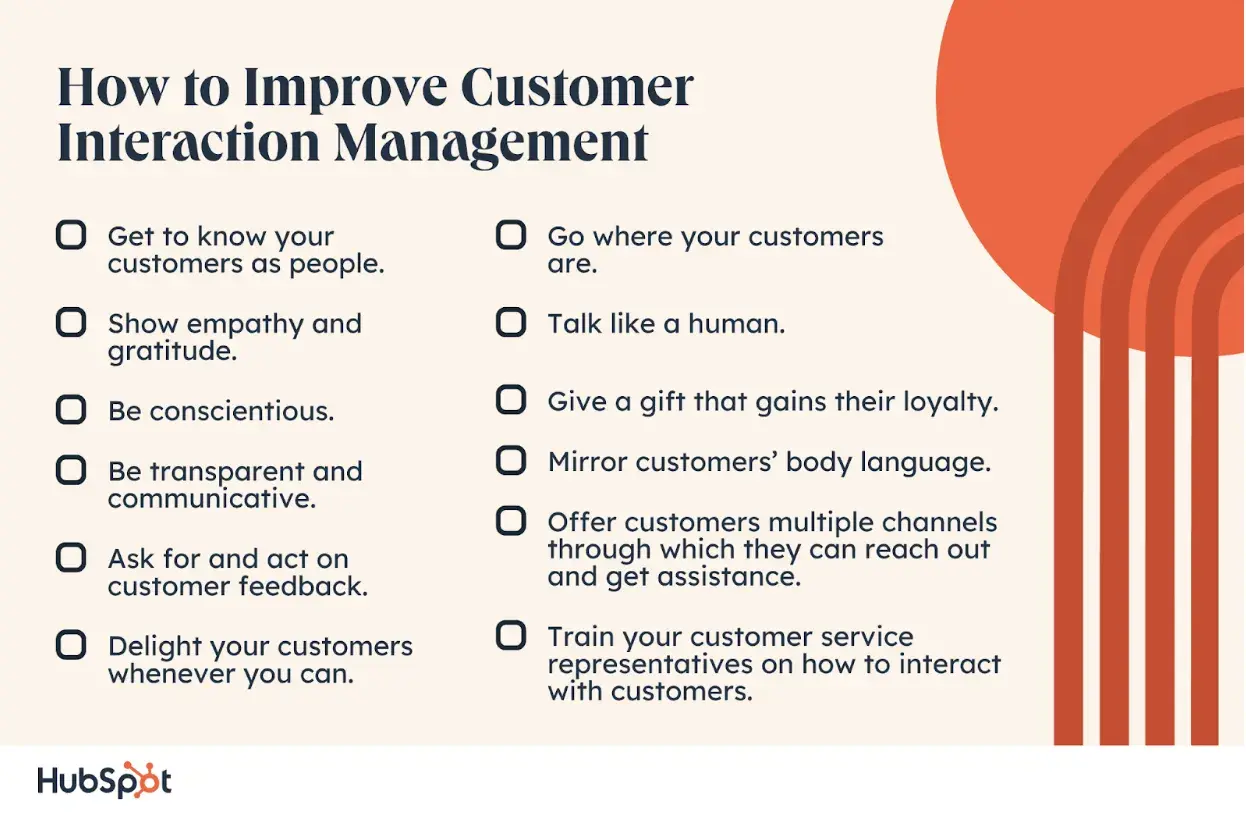
1. Get to know your customers as people.
The biggest takeaway from my entire career has been that people are people no matter what. Customers, businesses, sales reps, marketing teams … every interaction you have in business comes back to people. I’ve discovered that understanding my customers as people and deeply familiarizing myself with their needs, motivations, and pain points makes all the difference. It’s hard to help people you know nothing about.
Will Yang, the head of growth and customer success at Instrumentl, believes getting to know your customers is the best way to improve customer interactions.
Yang says he has worked with many companies that struggle with customer service. The biggest challenge? “They didn’t really know their customers,” Yang recounts. “So when they interacted with them, the conversations were awkward and uncomfortable.
When sharing his top tip, Yang says, “Train your employees to understand your customers as people first — and then equip them with tools and resources so that they can help your customers in a way that makes sense for them personally.”
2. Show empathy and gratitude.
Demonstrating empathy and gratitude goes a long way in building strong customer relationships. If I approach every customer interaction with an openness and genuine desire to help, everything else falls into place.
Here are some ways to do that:
- Thank your customers for everything. Without their business, you wouldn’t be here.
- Apologize sincerely when things go wrong. Sh*t happens. Everyone knows that. I’ve found that customers won’t hold things against you if you meet them with transparency and a genuine “I’m sorry” when needed.
- Acknowledge their feelings and experiences. Validating your customers in challenging and uplifting moments reinforces their relationships with your brand.
Empathy and gratitude are mindsets. If you can approach each customer interaction with positivity and the best intentions, your customers will return the favor.
3. Be conscientious.
I learned this lesson the hard way when I no-showed a meeting with my career counselor in college. My counselor wasn’t angry or upset, but he sent me a simple email stating the importance of honoring my commitments, and I never forgot it.
The same thing applies to customer relationships. Be responsible and respectful of your customers by following up after interactions and making it clear that you care about their satisfaction. After all, you committed to solving their needs when they became customers.
Marnix Broer, the CEO and co-founder of Studocu, believes that you can make a significant impact and improve customer interactions long after the initial call.
“Post-service check-ins are small moves that show your customers you care about their results,” says Broer. “You can automate and personalize follow-up SMS and email after customer interactions to see how your solutions worked for them and offer any extra help.
Broer notes that check-ins are a great way to go above and beyond. “With a check-in, you can make the lasting memory your company leaves on customers a positive one,” he says.
4. Be transparent and communicative.
Honesty is always the best policy. Throughout my career as a support rep at HubSpot and as a small business owner, I’ve learned that transparency and open communication are always the best way forward, especially in challenging situations. The last thing you want is to make customers feel blindsided or like they are being kept in the dark.
- Communicate openly about issues and resolution times. Be upfront about timelines.
- Keep customers informed about updates or changes to your products/services
- Be upfront about policies, pricing, and procedures.
5. Ask for and act on customer feedback.
Customer feedback is a precious gift.
It provides insights into what you are doing well and where you can improve. I’ve discovered that customers appreciate feeling like their opinion matters, and the best way you can do that is by genuinely listening to what they have to say and implementing changes based on their feedback.
6. Delight your customers whenever you can.
Surprising your customers with unexpected gifts or gestures can create long-lasting positive impressions. Exceeding expectations builds long-term excitement and reinforces the customer relationship.
Delighting customers is easier said than done, requiring an intimate understanding of their needs and what makes them tick. Here are some small things you can do for your customers to show them you care:
- Send personalized thank-you notes.
- Shout out customers on social media.
- Offer exclusive discounts and promotions.
In my instrument rental business, I like to hide handwritten thank-you notes in places like guitar cases or drum bags to surprise customers when I send gear out. It’s a small gesture, but it shows customers that I appreciate them, and the element of surprise elevates the whole experience.
7. Go where your customers are.
As a customer, I find it frustrating to chase down customer support. For example, if I send an Instagram DM to a brand with a question or issue and they respond by saying, “Please contact us at XYZ,” that’s annoying.
Don’t give your customers the runaround. Be available on every channel your customers use to make it easy for them to interact with your brand.
- Be active on your customers' preferred social media channels.
- Offer omni-channel support.
- Respond promptly to customers on the platform they contacted you on and keep the conversation there.
8. Talk like a human.
Customers just want to be treated like people, and people don’t usually say things like “synergy” and “let’s circle back on that” in real life. Avoid corporate jargon and communicate with customers in a genuine and relatable way.
Maybe it has to do with social media, but as a millennial, I’m hypersensitive to inauthentic corporate speech, and I think that goes double for younger generations. Once again, customers are just people, and businesses are made up of people, so can we all just agree to talk to each other like people?
9. Give a gift that gains their loyalty.
A small token of appreciation can go a long way in turning customers into loyal advocates. You might consider:
- Sending gift cards or discounts as thank-yous.
- Offering a loyalty reward program.
- Recognizing customers on their birthdays with personalized outreach and a small gift or discount code.
My favorite example of this is Sweetwater. They send me (and all customers) a little bag of candy with each order.
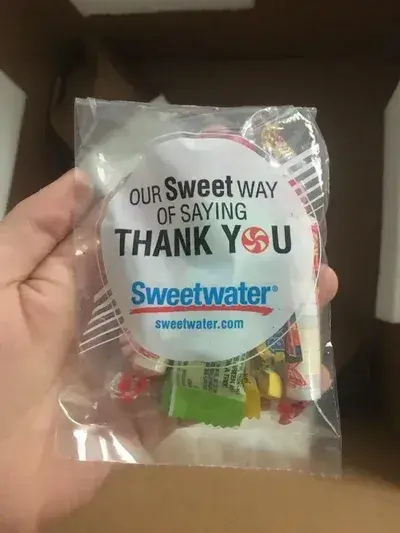
How can you not love that?! It adds a little splash of delight and excitement to every order and makes me happy about being a customer.
10. Mirror the body language of your customers.
Face-to-face interactions offer a whole new layer of connection with your customers.
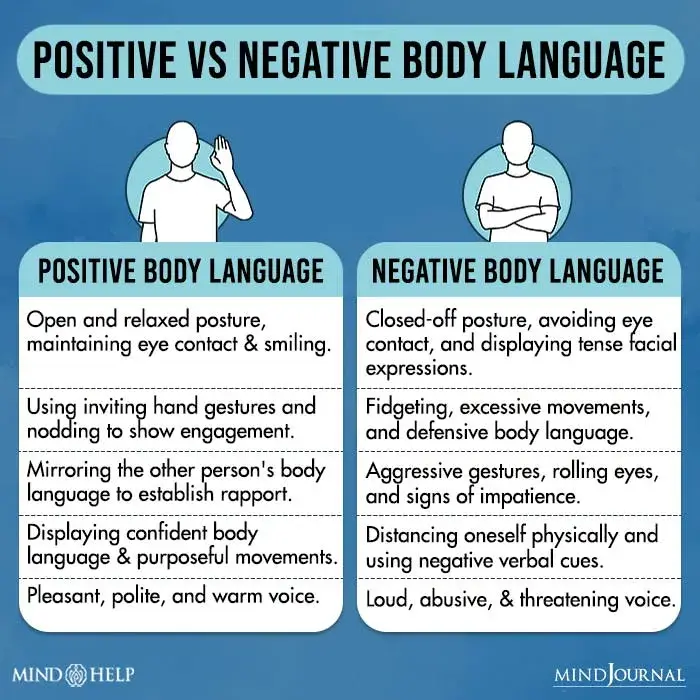
Displaying positive, open body language and subtly mirroring the customer’s body language can make them feel more at ease. I’ve found that even if you are speaking to a customer on the phone, smiling and relaxing your body language can positively impact the tone of the conversation.
In sensitive industries like healthcare, being mindful of your body language is even more critical in creating positive customer interactions. Alex Milligan, the co-founder and CMO of NuggMD, a telemedicine company, often encounters nervous clients who are uncertain about the outcome of their consultations. He’s found that mimicking the person’s subtle actions and responses helps build trust and familiarity.
“In most cases, people won’t notice that you’re copying them,” Milligan says. “Instead, they feel like you speak their language and understand them, which helps you to establish a positive rapport.”
11. Offer customers multiple channels through which they can reach out and get assistance.
I’ll say it once, and I’ll say it again: omni-channel service or bust. Customers today expect to be able to reach you by any means possible. That means email, phone, live chat, or social media. Allowing your customers to reach you in various ways reduces their frustration, enhances their experience, and even lightens the load on your support teams.
Normand Chevrette, the President and CEO of CME Corp, ensures that CME Corp’s customers can reach them through many channels.
She says that if clients encounter urgent equipment problems, they can coordinate with dedicated, local account managers for immediate guidance. They can also explore a user-friendly website and find helpful resources, like articles and ebooks.
“For more complex problems, a phone support option is available, as it connects them to our knowledgeable customer service representatives,” Chevrette says. “With this multi-channel approach, we ensure healthcare professionals receive prompt and personalized assistance...”
12. Train your customer service representatives on how to interact with customers.
When asked about the secret to improving customer interactions, Young Pham, the co-founder and senior project manager at BizReport, simply replied, “The idea of learning should be fully integrated into the normal day-to-day operations of the customer support department.”
I’m inclined to agree. As a former HubSpot Support rep, I can attest that crafting meaningful customer interactions is a skill that requires honing. I’m grateful we had an extensive training and mentorship program at HubSpot Support and a culture prioritizing continuous learning and development.
Make Your Customers Love Interacting with Your Business
We live in a highly competitive world, and how you interact with customers has a lasting impact on your reputation and bottom line. Creating consistently positive customer interactions starts at the cultural level. Your whole company needs to be laser-focused on customer needs and how to solve them. It may sound daunting, but I believe excellent customer interactions come naturally if underpinned by a genuine, empathetic desire to help.
Happy customers are loyal customers, and loyal customers will keep your business afloat. So, pay attention to your customer interactions and let your customers tell you how to best help them — and they’ll return the favor.
Net Promoter, Net Promoter System, Net Promoter Score, NPS and the NPS-related emoticons are registered trademarks of Bain & Company, Inc., Fred Reichheld and Satmetrix Systems, Inc.
Editor's note: This article was originally published in June 2018 and has since been updated for comprehensiveness.
Customer Experience


.webp)



![Is The Customer Always Right? [What It Means + Why It Matters]](https://53.fs1.hubspotusercontent-na1.net/hubfs/53/customer-is-always-right-origin-1-20250202-6448090.webp)





